 Hello, I am a beginner at electronics. I have two AC to DC converters ((3),(5) in image). The converter with the number 3 is connected parallel with my room's light bulb. It converts 220v AC to 12V DC 1.2 A. The converter number 5 is a small 220v AC to 12v DC 450mA converter. Devices 4 and 6 are arduinos. Number 7 is a switch. and number 1 electricity mains. The problem is that when I attach the number 5 on the circuit then it draws all the current and number 3 does not light up. Why?
Hello, I am a beginner at electronics. I have two AC to DC converters ((3),(5) in image). The converter with the number 3 is connected parallel with my room's light bulb. It converts 220v AC to 12V DC 1.2 A. The converter number 5 is a small 220v AC to 12v DC 450mA converter. Devices 4 and 6 are arduinos. Number 7 is a switch. and number 1 electricity mains. The problem is that when I attach the number 5 on the circuit then it draws all the current and number 3 does not light up. Why?
Update: I have an arduino inside my light switch which takes values from a trimmer and send it to a Central Arduino which send them to the Arduino which is parallel connected to the light bulb and dimms the light using a phase control module.
when I disconnect the inverter number 5 the circuit works perfectly. When I connect it back the LED on the converter number 5 turns constantly on but the LED on the converter number 3 turns on for some milliseconds and fade out. With a result the arduino parallel connected to the light bulb to not work
Update 2:
This is the complete circuit. I use nrf24l01 modules to communicate between arduinos. The dimmer is a circuit that detects the zero-crossing and uses a triac to control current. There is a tutorial on Instructables.

